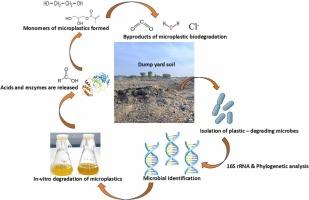模拟垃圾场微生物驱动聚丙烯和聚氯乙烯微塑料的显著生物降解
IF 11.3
1区 环境科学与生态学
Q1 ENGINEERING, ENVIRONMENTAL
引用次数: 0
摘要
利用细菌培养分离物首次展示了聚丙烯(PPs)和聚氯乙烯(pvc)微塑料的分解。利用宏基因组学和系统发育分析,从模拟垃圾场中发现了细菌分离株。采用鲍曼不动杆菌和芽孢杆菌为主的混合培养菌株分离PPs和pvc。活性50 d后,由于鲍曼不动杆菌的分解作用,微塑料的干重分别下降了33.3% (PPs)和27.1% (pvc)。在混合细菌培养中,分别观察到PPs和pvc的体重减轻20.3%和18.2%。根据DTG、NMR、拉曼和WCA等实验,微塑料的热稳定性和过渡性质发生了变化。FTIR分析捕捉到了PPs和pvc的结构变化。扫描电镜、透射电镜和细胞疏水性测试表明,微塑料具有生物降解性。气相色谱-质谱联用技术鉴定了其释放的副产物,包括羧酸、烷烃、酯类和芳香族化学物质。基于这些发现,可以得出结论,细菌分离物可以有效降解PPs和pvc,并可能有助于创造可持续处理塑料垃圾的方法。本文章由计算机程序翻译,如有差异,请以英文原文为准。

Simulated Dump Yard Microbes Drive Significant Biodegradation of Polypropylene and Polyvinyl Chloride Microplastics
Bacterial culture isolates were used to demonstrate the breakdown of polypropylene (PPs) and polyvinyl chloride (PVCs) microplastics for the first time. Using metagenomics and phylogenetic analysis, bacterial isolates were discovered from a simulated dump yard. PPs and PVCs were broken down using bacterial isolates found to be Acinetobacter baumannii and mixed culture species with a Bacillus sp. dominance. After 50 days of activity, the dry weight of microplastics decreased by 33.3% (PPs) and 27.1% (PVCs) due to the breakdown process aided by Acinetobacter baumannii.Weight reductions of 20.3% for PPs and 18.2% for PVCs have been observed in mixed bacterial cultures, respectively. Microplastics' thermal stability and transition properties changed, according to experiments like DTG, NMR, Raman, and WCA. FTIR analysis captured the structural changes in PPs and PVCs. SEM, TEM, and cell hydrophobicity tests showed that microplastics were biodegrading. GC-MS identified the released byproducts, which included carboxylic acids, alkanes, esters, and aromatic chemicals. Based on these findings, it can be concluded that bacterial isolates are effective in degrading PPs and PVCs and may help create sustainable methods of handling plastic trash.
求助全文
通过发布文献求助,成功后即可免费获取论文全文。
去求助
来源期刊

Journal of Hazardous Materials
工程技术-工程:环境
CiteScore
25.40
自引率
5.90%
发文量
3059
审稿时长
58 days
期刊介绍:
The Journal of Hazardous Materials serves as a global platform for promoting cutting-edge research in the field of Environmental Science and Engineering. Our publication features a wide range of articles, including full-length research papers, review articles, and perspectives, with the aim of enhancing our understanding of the dangers and risks associated with various materials concerning public health and the environment. It is important to note that the term "environmental contaminants" refers specifically to substances that pose hazardous effects through contamination, while excluding those that do not have such impacts on the environment or human health. Moreover, we emphasize the distinction between wastes and hazardous materials in order to provide further clarity on the scope of the journal. We have a keen interest in exploring specific compounds and microbial agents that have adverse effects on the environment.
 求助内容:
求助内容: 应助结果提醒方式:
应助结果提醒方式:


